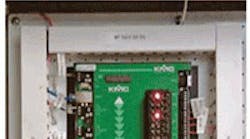Built in 1976, the seven-story, 192,290-sq-ft Seattle Life Sciences Center in downtown Seattle is a mixed-use facility with office, laboratory, and research space. It is home to medical practitioners, as well as research and biotechnology firms.
The Life Sciences Center uses steam for several processes. Condensate from the steam’s use was collected and dumped down the drain. Further, hot condensate was tempered with domestic water to prevent the city sewage system from being overheated and glass drains throughout the building from breaking. This was not an approach favored by the building's owner, Alexandria Real Estate Equities (ARE); the building's tenants; or the city.
Steve Depew, a consulting/design engineer with Engineered Building Controls of Burien, Wash., and Roger Norman, owner of Northwest Automation of Tonasket, Wash., designed and installed a system that captures all of the hot condensate throughout the building and pumps it to storage tanks in the mechanical room.
Heat from exhaust fans is reclaimed, while a plate-and-frame heat exchanger is used to extract heat from the stored condensate. In turn, the condensate is put down the drain at acceptable temperatures. Captured heated water is used to preheat the 100-percent outside air at the air-handling-unit (AHU) intake, which dramatically reduces the need for steam heat. During warmer weather, the heated loop water is diverted to exhaust-fan coils for heat rejection to outside air.
Seeing an opportunity to prevent the steam coils from freezing, Depew used the heat-recovery system to provide freeze protection. This meant no more cracked steam-coil headers flooding the lower floors and no more 3 a.m. AHU freeze-protection shutdowns requiring emergency calls to the facility engineers.
The entire heat-recovery system and four AHUs, which previously were under proprietary control, are controlled with the BAC-A1616BC BACnet Building Controller (B-BC) from KMC Controls. Its capabilities are extended through the use of four KMC B-BC expansion modules. Various KMC valves and sensors complete the control subsystem.
The KMC building controller serves up its own Web pages. These pages integrate nicely into the operator workstation of the existing Alerton BACtalk control system. Thus, the newer control functions became a seamless part of the overall building-automation scheme.
ARE anticipates a three-year payback for the heat-recovery system through measures such as reduced steam demand, elimination of water used for tempering condensate before dispelling, and reduced sewage charges because of lower volume of water dispelled.
Information and photographs courtesy of KMC Controls Inc.
For Design Solutions author guidelines, call Scott Arnold, executive editor, at 216-931-9980, or write to him at [email protected].









